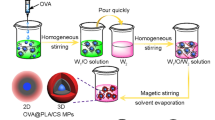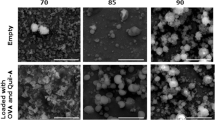Abstract
This report extensively explores the benefits of including chitosan into poly-ε-caprolactone (PCL) nanoparticles (NPs) to obtain an improved protein/antigen delivery system. Blend NPs (PCL/chitosan NPs) showed improved protein adsorption efficacy (84%) in low shear stress and aqueous environment, suggesting that a synergistic effect between PCL hydrophobic nature and the positive charges of chitosan present at the particle surface was responsible for protein interaction. Additionally, thermal analysis suggested the blend NPs were more stable than the isolated polymers and cytotoxicity assays in a primary cell culture revealed chitosan inclusion in PCL NPs reduced the toxicity of the delivery system. A quantitative 6-month stability study showed that the inclusion of chitosan in PCL NPs did not induce a change in adsorbed ovalbumin (OVA) secondary structure characterized by the increase in the unordered conformation (random coil), as it was observed for OVA adsorbed to chitosan NPs. Additionally, the slight conformational changes occurred, are not expected to compromise ovalbumin secondary structure and activity, during a 6-month storage even at high temperatures (45°C). In simulated biological fluids, PCL/chitosan NPs showed an advantageous release profile for oral delivery. Overall, the combination of PCL and chitosan characteristics provide PCL/chitosan NPs valuable features particularly important to the development of vaccines for developing countries, where it is difficult to ensure cold chain transportation and non-parenteral formulations would be preferred.






Similar content being viewed by others
References
Junqueira-Kipnis AP, Marques Neto LM, Kipnis A. Role of fused immunogens and adjuvants in modern tuberculosis vaccines. Front Immunol. 2014;5:188. doi:10.3389/fimmu.2014.00188.
Tan ML, Choong PF, Dass CR. Recent developments in liposomes, microparticles and nanoparticles for protein and peptide drug delivery. Peptides. 2010;31(1):184–93. doi:10.1016/j.peptides.2009.10.002.
Al-Tahami K, Singh J. Smart polymer based delivery systems for peptides and proteins. Recent pat Drug Deliv Formul. 2007;1(1):65–71.
Shaji J, Patole V. Protein and peptide drug delivery: oral approaches. Indian J Pharm Sci. 2008;70(3):269–77. doi:10.4103/0250-474X.42967.
Amidi M, Mastrobattista E, Jiskoot W, Hennink WE. Chitosan-based delivery systems for protein therapeutics and antigens. Adv Drug Deliv rev. 2010;62(1):59–82. doi:10.1016/j.addr.2009.11.009.
Baldrick P. The safety of chitosan as a pharmaceutical excipient. Regulatory Toxicology and Pharmacology: RTP. 2010;56(3):290–9. doi:10.1016/j.yrtph.2009.09.015.
Lebre F, Borchard G, de Lima MC, Borges O. Progress towards a needle-free hepatitis B vaccine. Pharm res. 2011;28(5):986–1012. doi:10.1007/s11095-010-0314-4.
Panos I, Acosta N, Heras A. New drug delivery systems based on chitosan. Curr Drug Discov Technol. 2008;5(4):333–41.
Borges O, Borchard G, de Sousa A, Junginger HE, Cordeiro-da-Silva A. Induction of lymphocytes activated marker CD69 following exposure to chitosan and alginate biopolymers. Int J Pharm. 2007;337(1–2):254–64. doi:10.1016/j.ijpharm.2007.01.021.
Woodruff MA, Hutmacher DW. The return of a forgotten polymer—polycaprolactone in the 21st century. Prog Polym Sci. 2010;35(10):1217–56. doi:10.1016/j.progpolymsci.2010.04.002.
Haas J, Ravi Kumar MN, Borchard G, Bakowsky U, Lehr CM. Preparation and characterization of chitosan and trimethyl-chitosan-modified poly-(epsilon-caprolactone) nanoparticles as DNA carriers. AAPS PharmSciTech. 2005;6(1):E22–30. doi:10.1208/pt060106.
Florindo HF, Pandit S, Goncalves LM, Alpar HO, Almeida AJ. Streptococcus equi antigens adsorbed onto surface modified poly-epsilon-caprolactone microspheres induce humoral and cellular specific immune responses. Vaccine. 2008;26(33):4168–77. doi:10.1016/j.vaccine.2008.05.074.
Gupta NK, Tomar P, Sharma V, Dixit VK. Development and characterization of chitosan coated poly-(varepsilon-caprolactone) nanoparticulate system for effective immunization against influenza. Vaccine. 2011;29(48):9026–37. doi:10.1016/j.vaccine.2011.09.033.
Florindo HF, Pandit S, Lacerda L, Goncalves LM, Alpar HO, Almeida AJ. The enhancement of the immune response against S. Equi antigens through the intranasal administration of poly-epsilon-caprolactone-based nanoparticles. Biomaterials. 2009;30(5):879–91. doi:10.1016/j.biomaterials.2008.10.035.
Jimenez-Ruiz E, Alvarez-Garcia G, Aguado-Martinez A, Salman H, Irache JM, Marugan-Hernandez V, et al. Low efficacy of NcGRA7, NcSAG4, NcBSR4 and NcSRS9 formulated in poly-epsilon-caprolactone against Neospora caninum infection in mice. Vaccine. 2012;30(33):4983–92. doi:10.1016/j.vaccine.2012.05.033.
Bilensoy E, Sarisozen C, Esendagli G, Dogan AL, Aktas Y, Sen M, et al. Intravesical cationic nanoparticles of chitosan and polycaprolactone for the delivery of Mitomycin C to bladder tumors. Int J Pharm. 2009;371(1–2):170–6. doi:10.1016/j.ijpharm.2008.12.015.
Mazzarino L, Travelet C, Ortega-Murillo S, Otsuka I, Pignot-Paintrand I, Lemos-Senna E, et al. Elaboration of chitosan-coated nanoparticles loaded with curcumin for mucoadhesive applications. J Colloid Interface Sci. 2012;370(1):58–66. doi:10.1016/j.jcis.2011.12.063.
Borges O, Borchard G, Verhoef JC, de Sousa A, Junginger HE. Preparation of coated nanoparticles for a new mucosal vaccine delivery system. Int J Pharm. 2005;299(1–2):155–66. doi:10.1016/j.ijpharm.2005.04.037.
Jesus S, Borchard G, Borges O. Freeze dried chitosan/poly-e-caprolactone and poly-e-caprolactone nanoparticles: evaluation of their potential as DNA and antigen delivery systems. J Genet Syndr Gene Ther. 2013;4(164). doi:10.4172/2157-7412.1000164.
Whitmore L, Wallace BA. Protein secondary structure analyses from circular dichroism spectroscopy: methods and reference databases. Biopolymers. 2008;89(5):392–400. doi:10.1002/bip.20853.
Martinac A, Filipovic-Grcic J, Voinovich D, Perissutti B, Franceschinis E. Development and bioadhesive properties of chitosan-ethylcellulose microspheres for nasal delivery. Int J Pharm. 2005;291(1–2):69–77. doi:10.1016/j.ijpharm.2004.07.044.
Rahman M, Laurent S, Tawil N, Yahia LH, Mahmoudi M. Nanoparticle and protein corona. Protein-nanoparticle interactions. Berlin Heidelberg: Springer; 2013. p. 21–44.
Dole MN, Patel PA, Sawant SD, Schedpure PS. Advance applications of Fourier transform infrared spectroscopy. Int J Pharm Sci Rev Res. 2011;7(2).
Roozbahani F, Sultana N, Fauzi Ismail A, Nouparvar H. Effects of chitosan alkali pretreatment on the preparation of electrospun PCL/chitosan blend Nanofibrous scaffolds for tissue engineering application. J Nanomater. 2013;2013:6. doi:10.1155/2013/641502.
Gregorio-Jauregui KM, Pineda MG, Rivera-Salinas JE, Hurtado G, Saade H, Martinez JL, et al. One-step method for preparation of magnetic nanoparticles coated with chitosan. J Nanomater. 2012;2012:8. doi:10.1155/2012/813958.
Duarte ML, Ferreira MC, Marvao MR, Rocha J. An optimised method to determine the degree of acetylation of chitin and chitosan by FTIR spectroscopy. Int J Biol Macromol. 2002;31(1–3):1–8.
Jang MK, Jeong YI, Cho CS, Yang SH, Kang YE, Nah JW. The preparation and characterization of low molecular and water soluble free-amine chitosan. Bull Korean Chem Soc. 2002;23(6).
Elzubair A, Elias CN, Suarez JC, Lopes HP, Vieira MV. The physical characterization of a thermoplastic polymer for endodontic obturation. J Dent. 2006;34(10):784–9. doi:10.1016/j.jdent.2006.03.002.
Zhetcheva VDK, Pavlova LP. Synthesis and spectral characterization of a decavanadate/chitosan complex. Turk J Chem. 2011;35:215–23. doi:10.3906/kim-1006-718.
Kong J, Yu S. Fourier transform infrared spectroscopic analysis of protein secondary structures. Acta Biochim Biophys sin. 2007;39(8):549–59.
Chakraborty S, Joshi P, Shanker V, Ansari ZA, Singh SP, Chakrabarti P. Contrasting effect of gold nanoparticles and nanorods with different surface modifications on the structure and activity of bovine serum albumin. Langmuir: the ACS Journal of Surfaces and Colloids. 2011;27(12):7722–31. doi:10.1021/la200787t.
Neto CGT, Giacometti JA, Job AE, Ferreira FC, Fonseca JLC, Pereira MR. Thermal analysis of chitosan based networks. Carbohyd Polym. 2005;62(2):97–103. doi:10.1016/j.carbpol.2005.02.022.
Ciardelli G, Chiono V, Vozzi G, Pracella M, Ahluwalia A, Barbani N, et al. Blends of poly-(epsilon-caprolactone) and polysaccharides in tissue engineering applications. Biomacromolecules. 2005;6(4):1961–76. doi:10.1021/bm0500805.
Persenaire O, Alexandre M, Degee P, Dubois P. Mechanisms and kinetics of thermal degradation of poly(epsilon-caprolactone). Biomacromolecules. 2001;2(1):288–94.
Mohamed A, Finkenstadt VL, Gordon SH, Biresaw G, Debra P, Rayas-Duarte P. Thermal properties of PCL/gluten bioblends characterized by TGA, DSC, SEM, and infrared-PAS. J Appl Polym Sci. 2008;110(5):3256–66. doi:10.1002/App.28914.
das Neves J, Amiji M, Bahia MF, Sarmento B. Assessing the physical-chemical properties and stability of dapivirine-loaded polymeric nanoparticles. Int J Pharm. 2013;456(2):307–14. doi:10.1016/j.ijpharm.2013.08.049.
Correlo VM, Boesel LF, Bhattacharya M, Mano JF, Neves NM, Reis RL. Properties of melt processed chitosan and aliphatic polyester blends. Mater Sci Eng a. 2005;403(1–2):57–68. doi:10.1016/j.msea.2005.04.055.
Li XM, Chen MM, Yang WZ, Zhou ZM, Liu LR, Zhang QQ. Interaction of bovine serum albumin with self-assembled nanoparticles of 6-O-cholesterol modified chitosan. Colloid Surface B. 2012;92:136–41. doi:10.1016/j.colsurfb.2011.11.030.
Huang RX, Carney RP, Stellacci F, Lau BLT. Protein-nanoparticle interactions: the effects of surface compositional and structural heterogeneity are scale dependent. Nanoscale. 2013;5(15):6928–35. doi:10.1039/C3nr02117c.
Greenfield NJ. Using circular dichroism spectra to estimate protein secondary structure. Nat Protoc. 2006;1(6):2876–90. doi:10.1038/nprot.2006.202.
Saptarshi SR, Duschl A, Lopata AL. Interaction of nanoparticles with proteins: relation to bio-reactivity of the nanoparticle. J Nanobiotechnol. 2013;11. doi:10.1186/1477-3155-11-26.
Ghosh G, Panicker L, Barick KC. Selective binding of proteins on functional nanoparticles via reverse charge parity model: an in vitro study. Mater Res Express. 2014;1(1). doi: 10.1088/2053-1591/1/015017.
Shang L, Wang Y, Jiang J, Dong S. pH-dependent protein conformational changes in albumin:gold nanoparticle bioconjugates: a spectroscopic study. Langmuir: the ACS Journal of Surfaces and Colloids. 2007;23(5):2714–21. doi:10.1021/la062064e.
Ranjbar B, Gill P. Circular dichroism techniques: biomolecular and Nanostructural analyses- a review. Chem Biol Drug des. 2009;74(2):101–20. doi:10.1111/j.1747-0285.2009.00847.x.
Fei L, Perrett S. Effect of nanoparticles on protein folding and fibrillogenesis. Int J Mol Sci. 2009;10(2):646–55. doi:10.3390/ijms10020646.
Borges O, Cordeiro-da-Silva A, Romeijn SG, Amidi M, de Sousa A, Borchard G, et al. Uptake studies in rat Peyer's patches, cytotoxicity and release studies of alginate coated chitosan nanoparticles for mucosal vaccination. Journal of Controlled Release: Official Journal of the Controlled Release Society. 2006;114(3):348–58. doi:10.1016/j.jconrel.2006.06.011.
Sogias IA, Williams AC, Khutoryanskiy VV. Why is chitosan mucoadhesive? Biomacromolecules. 2008;9(7):1837–42. doi:10.1021/bm800276d.
Sonia TA, Sharma CP. Chitosan and its derivatives for drug delivery perspective. Chitosan for Biomaterials I. 2011;243:23–53. doi:10.1007/12_2011_117.
Sinha VR, Singla AK, Wadhawan S, Kaushik R, Kumria R, Bansal K, et al. Chitosan microspheres as a potential carrier for drugs. Int J Pharm. 2004;274(1–2):1–33. doi:10.1016/j.ijpharm.2003.12.026.
Acknowledgments
This work was supported by Portuguese Foundation for Science and Technology (FCT)—project PTDC/SAU-FAR/115044/2009, by the Center for Neuroscience and Cell Biology, University of Coimbra, PEst-C/SAU/LA0001/2013-014, by FCT fellowship DFRH—SFRH/BD/81350/2011, and by FCT in cooperation with Coordenação de Aperfeiçoamento de Pessoal de Nível Superior (CAPES, Brazil)—FCT/CAPES Proc.N.329/13.
Author information
Authors and Affiliations
Corresponding author
Electronic Supplementary Material
Supplemental 1
(DOCX 151 kb)
Supplemental 2
(DOCX 94 kb)
Supplemental 3
(DOCX 326 kb)
Supplemental 4
(DOCX 327 kb)
Rights and permissions
About this article
Cite this article
Jesus, S., Fragal, E.H., Rubira, A.F. et al. The Inclusion of Chitosan in Poly-ε-caprolactone Nanoparticles: Impact on the Delivery System Characteristics and on the Adsorbed Ovalbumin Secondary Structure. AAPS PharmSciTech 19, 101–113 (2018). https://doi.org/10.1208/s12249-017-0822-1
Received:
Accepted:
Published:
Issue Date:
DOI: https://doi.org/10.1208/s12249-017-0822-1




